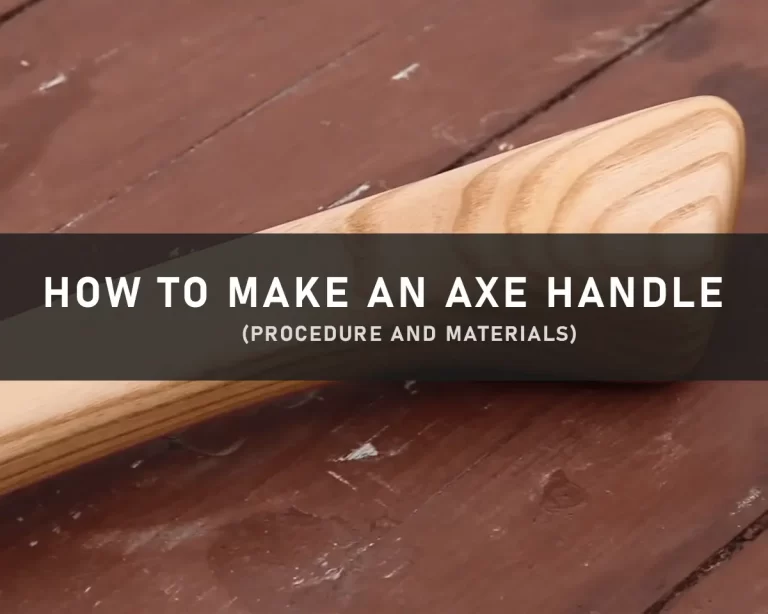5+ Best Wood for Axe Handle – Find your Perfect Fit
An axe is a powerful tool used for several purposes, from cutting wood to axe-throwing games. If you are a DIY enthusiast and like to make your axe, choosing the best wood for axe handle can be confusing. Everyone desires a powerful handle that only comes off slowly and is worn out over time.
Different companies are known for manufacturing good axe handles. Depending on the desired features, you can either buy them or make them on your own from wood like hickory, oak, ash or some other. Strength is important when deciding on wood for making an axe handle.
Let’s go through some most commonly used woods for axe handles, reasons to use them, and features of good quality wood.
What Wood is Best for Axe Handles? Axe-Throwing Special
The head of the axe and handle are equally important when it comes to the work efficiency of an axe. In axe throwing, having a non-slippery handle and a steady grip is essential to reach your intended target. Here are some top-quality woods that you can use for making your axe handles.
| Wood Type | Modulus of Elasticity (GPa) | Texture | Grain Structure |
| Hickory | 12.4 – 16.6 | Medium to coarse | Straight or slightly wavy |
| Ash | 10.3 – 13.8 | Coarse | Straight |
| Hard Maple | 11.0 – 13.8 | Fine to medium | Straight |
| Oak | 11.7 – 15.5 | Coarse to medium | Straight to interlocked |
| Birch | 8.3 – 10.3 | Fine to medium | Straight |
| Cherry | 9.0 – 12.4 | Fine to medium | Straight |
| Walnut | 9.7 – 12.4 | Coarse to fine | Straight to irregular |
| Beech | 10.3 – 13.8 | Fine to medium | Straight |
1 – Hickory Wood: The Ultimate Best
While looking for what wood to use for axe throwing handles, hickory wood is your best bet. It has exceptional strength, durability, and shock resistance. Hickory has flexural strength, meaning it can easily withstand the impact of heaving blows and jerky throws without breaking.
The hickory wood also has high toughness, allowing it to absorb shock and reduce possible vibrations during the throw. It has a tight grain structure, an additional point to its strength and resilience, making it a top-class choice for professional axe manufacturers.
2 – AshWood: A Reliable Alternative
Ashwood is popular among axe handle makers all over Europe. It is not as strong as hickory wood but offers excellent durability and shock resistance. It is light in weight compared to hickory wood, making it a suitable choice for axes used in throwing games.
Ash also has good flexibility, providing a comfortable grip and reducing strain on your hands during extensive games. Ash wood is less commonly available in North America than hickory due to ash borer beetle infestation.
3 – Hard Maple Wood: Strength and Precision
Hard maple wood is known for its dense and durable qualities. It is a viable option after the ash and hickory for making axe-throwing handles. Hard maple handles can add weight to the broad axe compared to ash wood but provide excellent strength and stability during the throw.
The dense grain structure of maple wood contributes to its resistance against impact and reduces the risk of splintering. A handle made of hard maple gives you a solid feel and enhances the accuracy of your throw.
4 – Birch Wood: Lightweight and Forgiving
Birchwood is famously known for its lightweight qualities, making it a good fit for axe-throwing handles. Especially when you are a beginner and learning how to throw an axe, birch wood handles will give you an edge to practice with easy handling and reducing the risk of slipping.
Axe handles made of birch wood offer good shock absorption, reducing the strain on your hands and arm during the throw. Their forgiveness factor can help to compensate for any minor inaccuracies in your technique.
It is important to note that birch wood is less durable than ash wood or hard as maple wood. It might need regular inspection and maintenance to avoid wear and tear on the axe handle.
5 – Oak Wood: Durable Over Time
Another option for an axe-throwing handle is oak wood, known for its irreplaceable durability. White oak is often preferred due to its excellent rot resistance and toughness. White oak is a bit heavier than oak or hickory wood; it is worthy due to its unmatched durability.
Oak wood can be challenging due to its grain structure. Handling it during the manufacturing, shaping, and finishing process needs skills and experience for the best results.
Other Options
Besides the five above-described wood, you can also use cherry, Walnut, and beech woods to make handles for throwing axes. They are light in weight, allowing flexibility in your movements during the throw. They might provide a different durability and shock absorption level than ash, hickory, or hard maple. Have a look at the table of important features of the above-described woods.
Qualities & Features of Wood for Axe Throwing Handles
Now, you have plenty of options on what type of wood is used for axe throwing. Not all kinds of tree wood are good for making axe handles; it depends on the types of throwing axes. Some qualities and features in described woods will help you improve your gaming skill’s precision.
| Quality/Feature | Description | How It Helps Your Game |
| Strength | The wood should be strong enough to withstand the impact of throws. | Prevents the handle from breaking or splintering during intense throws. |
| Durability | It should have good resistance to breaking, splintering, and wear. | Ensures the handle can withstand repeated throws without damage. |
| Shock Absorption | The wood should absorb and dampen the vibrations caused by impacts. | Reduces the strain on your hands and improves comfort during throws. |
| Flexibility | A certain level of flexibility helps reduce strain on the hands. | Provides a comfortable grip and reduces fatigue during longer sessions. |
| Lightweight | Lighter woods can improve control and maneuverability during throws. | Enhances accuracy and allows for quick adjustments in the throwing technique. |
| Grain Structure | A tight and straight grain promotes strength and reduces splintering. | Increases the overall durability and prevents the handle from breaking. |
| Availability | Consider the accessibility and availability of the wood in your area. | Ensures you can easily source and replace handles when needed. |
| Workability | Some woods are easier to shape, sand, and finish for the handle. | Allows for customization and shaping the handle to your desired grip. |
| Knots and Defects | Avoid woods with knots, cracks, or other structural weaknesses. | Prevents weak spots that could compromise the handle’s integrity. |
| Maintenance | Consider the level of care and maintenance required for the wood. | Allows for proper upkeep and ensures the handle’s longevity. |
Conclusion
End of the discussion best wood for an axe handle includes hickory, ash, maple, oak, and beech wood. Consider other factors, such as flexibility, grain structure, forgiveness element, durability, shock absorption, and availability, to select wood for your axe handle. Note that your axe handle should enhance the tendency of your throw rather than hold it back.
Share the desired qualities that you are looking for in a wood to use for making your axe handle.







